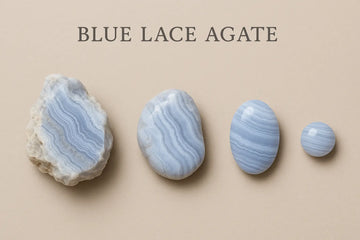There is a place where the sky grows tired of its own vastness and, longing for touch, whispers itself into stone. It does not choose the hard, cold density of sapphire or the deep, oceanic plunge of lapis. Instead, it chooses something softer, something that captures not the sky’s fury, but its most tranquil, breathless moment. That whisper, that captured sigh of cerulean and cloud, is Blue Lace Agate.
To hold a polished piece is to hold a stilled landscape. Its bands are not mere lines; they are the gentle ripples of a forgotten shoreline, the delicate strata of a morning horizon moments before the sun burns the mist away. It feels cool and light in the palm, a quiet antithesis to the roaring, volcanic birth of other stones. Its story is not one of fire and pressure, but of patient, siliceous seepage—a slow, geological poetry written in chalcedony.
This is the story of the stone that doesn’t demand attention, but earns it through a quiet promise of calm.
A Geological Rarity
Not all agates are created equal. Most tell tales of rich, rusty reds and earthy browns, colors painted by iron oxides seeping through silica-rich groundwater in the cavities of ancient lava flows. But Blue Lace Agate is a different verse in the same poem. Its unique palette is a masterpiece of chemistry and circumstance.
The soft blue hues are a gift from traces of chromium and vanadium, elements that paint with a cooler, more delicate brush than iron. The exquisite, lace-like banding forms through a process of breathtaking precision. As mineral-rich water percolates through rock, it deposits microscopic layers of silica, each layer a single brushstroke in a painting that takes millennia to complete. Variations in pressure, temperature, and mineral content create the rhythmic bands, the delicate waves that seem to pulse with a silent, frozen energy.
For decades, the world’s only significant source was a handful of mines near Otjiwarongo in Namibia, South Africa, a place of dry, rugged plains that in the local Bantu language translates as "beautiful place". The scarcity of this single source added to its allure. It was the sky’s secret, hidden in the African earth. While minor deposits have been identified in India and Brazil, the Namibian material remains the standard against which all others are judged—the truest, clearest, most sky-reflecting of them all.
The Stone of the Diplomat
History does not record Blue Lace Agate in the crowns of emperors or the hilts of conquerors' swords. Its energy is not for the battlefield or the throne room. Its history is quieter, woven into the fabric of communication and compassion.
Ancient civilizations that encountered agate prized it for its protective qualities, but Blue Lace, with its soothing appearance, was often singled out. It was said to be a talisman for orators, diplomats, and healers—those who needed to temper their words with kindness and their actions with empathy.
Roman soldiers might carry a brown agate for strength, but a statesman might keep a blue lace in his pocket to cool heated debates and allow for clear, compassionate communication. It was the stone of the throat chakra before such concepts had names in the West, a tool for speaking one’s truth with grace and for listening with an open heart.
It is the stone of the mediator, the teacher, the therapist—anyone who must hold space for the emotions of others without being overwhelmed. It doesn’t build walls; it opens windows, allowing for a fresh, calming breeze to flow through difficult conversations.
The Modern Balm
In our hyper-connected, perpetually buzzing world, the value of Blue Lace Agate has not diminished; it has skyrocketed. It has found its moment in history. It is the antidote to the notification, the calm after the scroll.
Its modern metaphysical properties are a direct reflection of our modern ailments:
-
For the Anxious Mind: It is known as a supreme calming stone. Its very appearance is a visual sedative. Holding it during moments of stress or anxiety is believed to gently soothe frayed nerves, not by numbing, but by creating a sense of expansive peace, like looking up at a wide, empty sky.
-
For the Struggling Communicator: It is the stone for anyone who struggles to find the right words, who clams up in conflict, or who speaks from a place of anger instead of clarity. It is said to empower gentle, truthful expression and to dissolve the fear of speaking up.
-
For the Empath: In wellness circles, it is considered a vital tool for highly sensitive people and empaths who easily absorb the negative energy of those around them. It is believed to create a gentle, protective filter around the wearer, allowing them to offer compassion without taking on the emotional burden of others.
You will not find it in loud, flashy displays. It is the stone tucked into the pocket of a student before a big presentation, strung on a bracelet worn by a new manager leading her first team meeting, or placed on the desk of a writer battling a blank page. Its work is intimate and personal.
The Art of the Lapidary
The journey from a rough, dull chunk of rock to a gleaming, banded marvel is a testament to human artistry. Blue Lace Agate is notoriously challenging to work with. Its delicate bands can be fragile, and its true beauty is only revealed through the skilled hands of a master lapidary, one who cuts, polishes, or shapes gemstones with various techniques to reveal their intrinsic beauty.
They must study the raw stone, creatively perceive the direction of its flow. Cutting it is an act of revelation, not imposition. One wrong cut can shatter the delicate lacework. The polishing is a slow, patient process, bringing out a waxy, vitreous luster that makes the blue seem to glow from within. The most common forms are polished free-form cabochons (a rounded shape as opposed to faceted), palm stones, and beads that capture the full, swirling landscape of the stone.
A Final Thought: The Currency of Calm
The economy of Blue Lace Agate is an interesting one. While not as prohibitively expensive as gems like diamonds, high-quality Namibian material commands a significant price. Its value is not measured in carats alone, but in the clarity of its blue, the delicacy and contrast of its banding, and its translucency.
But perhaps its true economy is emotional. In a world where stress is the default, calm becomes a precious commodity. Blue Lace Agate is a tangible piece of that economy. It is a physical anchor to a slower, softer, more gentle way of being. It doesn’t shout about transformation or instant manifestation; it whispers a promise of patience, clarity, and peace.
To wear Blue Lace Agate is to carry a piece of the quietest, most compassionate sky with you. It is a reminder that the most powerful voice is not always the loudest, and that true strength often lies in the ability to be still, to listen, and to speak with a heart as open as the horizon.



